Highway shield
A highway shield or route marker is a sign denoting the route number of a highway, usually in the form of a symbolic shape with the route number enclosed. As the focus of the sign, the route number is usually the sign's largest element, with other items on the sign rendered in smaller sizes or contrasting colors. Highway shields are used by travellers, commuters, and all levels of government for identifying, navigating, and organising routes within a county, state, province, or country. Simplified highway shields often appear on maps.
Purposes
There are several distinct uses for the highway shield:
- Junction signs inform travelers that they are approaching an intersection with a numbered highway.
- Guide signs inform travelers which way to go at intersections, usually with an arrow pointing the way. These include:
- Directional assemblies, which combine highway shields with separate cardinal direction signs and arrow signs on the same post, and
- Direction, position, or indication signs, which include highway shields as part of the sign legend.
- Reassurance markers are used after major junctions and periodically in between to confirm the route and direction.
- Trailblazer assemblies are posted on other roadways to "blaze the trail" to the highway in question, usually with a "TO" banner plate above the shield
- Some jurisdictions place highway shields on highway location markers (kilometre or mile markers).
Highway shields by country
- This transport-related list is incomplete; you can help by expanding it.
Australia
Australia has maintained distinctly different trends pertaining to Highway shields in the past and will continue in this vein somewhat, despite the conversion to alpha-numeric routes and shields. Alpha-numeric route numbering has been in use in Tasmania since the 1970s. However, from 1996 states on the mainland began conversion to the alpha-numeric system. The state of Victoria was the first to implement the policy. Prior to this conversion and concurrently, Federal Highway (gold-on-green squared-off bullet), National Highway (black-on-white squared-off bullet), State Highway (blue bullet) and Tourist Route (white-on-brown rounded pentagon) shields existed. In Victoria Freeway shields were used (white-on-green with 'F' prefix) until the late 1980s, while during the 1990s Queensland and New South Wales implemented a hexagonal blue-on-white Metroad system of urban arterial routes. With the opening of the Western Ring Road (now M80); that road used a shield quite similar to the U.S. Interstate shield, albeit with 'Ring Road' written instead of 'Interstate' and with 2 peaks, rather than 3. To further complicate matters, with the introduction of the alpha-numeric system, roads that are federally funded (or Federal Highways) have a squared-off bullet encompassing the alpha-numeric designation. Freeways and dual-carriageway roads often use an 'M' prefix, particularly in Victoria. In addition, trapezoidal signs are placed every 5 km on major regional highways and freeways indicating the distance to the post office of the next city or major town on the route. These signs usually only have the first letter of the destination; two or three letters are used if there is ambiguity between nearby towns or when the place name consists of two words.
![]()

![]()
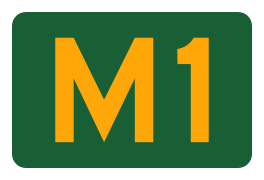
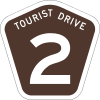




![]()
Brazil
Federal and state highways shields are standardized in Brazil by the National Transit Department (DENATRAN), but implementation is not always consistent nor even existent. In many states, highway names appear on highway location markers and guide signs with no highway shield.
 BR-101 federal highway shield as it appears in Rio Grande do Sul state
BR-101 federal highway shield as it appears in Rio Grande do Sul state BR-116 federal highway shield as it appears in Rio de Janeiro state
BR-116 federal highway shield as it appears in Rio de Janeiro state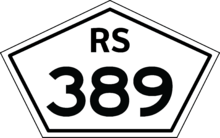 RS-389 state highway shield in Rio Grande do Sul
RS-389 state highway shield in Rio Grande do Sul SP-270 state highway shield in the state of São Paulo
SP-270 state highway shield in the state of São Paulo
Canada
Each province dictates the type of shields used as their highway system is a provincial responsibility.
Ontario
Ontario highways shields vary in shape and colour. The general format is a black letter/numbers on white background.
Major or 400-series highways use a white bullet with a crown on top. These are referred to as King's Highway markers, but the wording has been removed since the 1990s and now just referred to as 400-series highway markers.
Secondary and local or county roads use an isosceles trapezoid as markers. Background colour is usually white, but they can be green. Tertiary road signs are rectangular in shape. Text is black or white and will indicate the county name.
Ontario Highway 407 is the only 400-series highway not to have a standard shield. The rectangular signs has generic 407 and ETR markers.
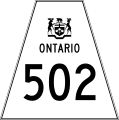 Typical Ontario secondary road signs using an isosceles trapezoid shield
Typical Ontario secondary road signs using an isosceles trapezoid shield Typical Ontario tertiary road signs using a rectangle
Typical Ontario tertiary road signs using a rectangle Typical Ontario county or local road sign marker using an inverted isosceles trapezoid
Typical Ontario county or local road sign marker using an inverted isosceles trapezoid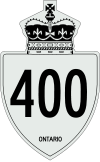 An Ontario 400-series using a bullet shaped shield
An Ontario 400-series using a bullet shaped shield 407 Express Toll Route using an oval marker
407 Express Toll Route using an oval marker
Toronto
Toronto's primary city-maintained freeways, the Gardiner Expressway and the Don Valley Parkway, both have shields. The design is a two-tone gold-on-green roundels, with the road name in white on the green outer ring, and either the cardinal direction (for reassurance markers) or an arrow (for guidance to the freeway) in black on the gold inner disc.
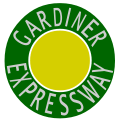 Gardiner Expressway shield
Gardiner Expressway shield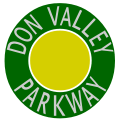 Don Valley Parkway shield
Don Valley Parkway shield
The city's other expressways, such as Allen Road, do not have their own shields.
Hong Kong
The Hong Kong Strategic Route and Exit Number System states that the standard shield should consist of a yellow, bullet-shaped shield with the route number in black color. It is used on all numbered routes in Hong Kong.

Malaysia
According to the Manual on Traffic Control Devices Standard Traffic Signs by Malaysian Public Works Department, a standard Malaysian highway shield consists of a yellow hexagon shield with black border line which resembles the Public Works Department's logo itself. The highway shield standard is used for all expressways, federal and state roads in Malaysia, which can be distinguished through the numbering scheme used (please refer to the Road signs in Malaysia article for details).
![]()
New Zealand
New Zealand shields are similar to the bullet-shaped markers used in Hong Kong, but are red rather than yellow.

Southern Africa
The Southern African Development Community Road Traffic Signs Manual specifies designs for "confirmation route markers" for numbered national, provincial, regional and metropolitan routes. The national route marker is pentagonal, the regional route marker is diamond-shaped, and the regional and metropolitan route markers are rectangular. The background is blue when used on a freeway and green for other roads. There is a white border and the lettering is yellow.[1]
 National route marker (freeway variant)
National route marker (freeway variant) Provincial route marker
Provincial route marker Regional route marker
Regional route marker Metropolitan route marker
Metropolitan route marker
United States

The United States' Manual on Uniform Traffic Control Devices (MUTCD) gives standard designs for highways in the Interstate Highway System and U.S. Route system. The Interstate shield is the only trademarked highway marker in use in the United States, and the U.S. Route shield was inspired by the Great Seal of the United States. The MUTCD also provides default designs for state highways (the circular highway shield) and county highways (a blue pentagon with yellow text).[2] However, states are free to use any design for their numbered routes; as of 2007 only five states (Delaware, Iowa, Kentucky, Mississippi, and New Jersey) use the default shield on their primary systems, and all others use a custom design. Oklahoma used the default until 2006, but changed to a state outline—however, many state routes still have the old default markers. Vermont uses the default for town-maintained sections of state highways, but has a different design for state-maintained sections. Maryland uses the default sporadically for locally maintained sections of state-numbered highways, most often in Baltimore, but otherwise uses a different design. Virginia uses the default for its secondary state routes but a different design for its primary state routes. There are several additional designs used in the other states and territories. State outlines are used for primary numbered routes in Alabama, Arizona, Arkansas, Florida, Georgia, Idaho, Louisiana, Missouri, Nevada, Ohio, and Oklahoma, and for secondary numbered routes in Texas. Tennessee and South Carolina incorporate state outlines into their shields as well. Many other designs are other geometric shapes (like squares and diamonds), or a design representing the state (like Pennsylvania's keystone design, Utah's beehive, Kansas' sunflower, and New Hampshire's Old Man in the Mountain). Washington uses a silhoutte of George Washington's bust. New Mexico uses the default circle but adds a Zia sun symbol inside the circle around the number. Every state but California uses a square or rectangular sign for its state highways, mainly to save money on both custom cutting and to be contained on a rectangular sign with other route markers. Some U.S. counties also have unique shield designs, though most use the MUTCD default.
Alternatives to shields
Many countries worldwide, such as the United Kingdom and France, do not use shields, instead relying on text representations of highway numbers. Road numbers (the term "highway" is not in general use in the UK) are prefixed by a letter indicating the type of road, for example M1, A1, B123 in the UK; A1, N1, D1 in France. These are sometimes highlighted with a different background color, depending on the class of highway and the context of the sign. The Vienna Convention on Road Signs and Signals specifies that "road identification signs" consist of the route number framed in a rectangle, a shield, or the relevant state's route classification symbol (if one exists).[3] The extent to which such signs are used varies between countries.
References
- ↑ SADC Road Traffic Signs Manual, Volume 1: Uniform Traffic Control Devices. National Department of Transport (South Africa). May 2012. p. 4.7.7. Retrieved 1 September 2014.
- ↑ Staff. "Section 2D.11". Manual on Uniform Traffic Control Devices. Federal Highway Administration.
- ↑ "CONVENTION ON ROAD SIGNS AND SIGNALS" (PDF). United Nations. pp. Art.17; p.14. Retrieved 2007-11-17.
External links
| Wikimedia Commons has media related to Highway signs. |